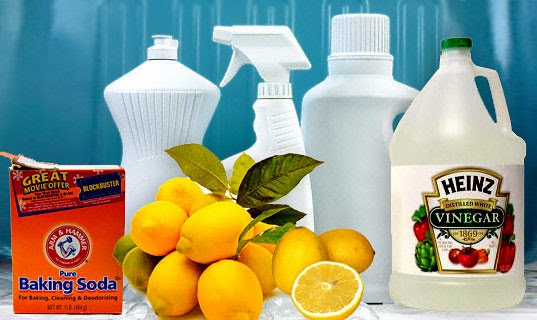The benefits of eating clean, nutritious, whole foods are clear--the fewer toxins, chemicals, and junk you feed your body, the more vibrant a life you'll lead. While the phrase "you are what you eat" stands true, the state of your environment can also impact your health. Here's what I have learned lately about detoxing my home.
Cleaning Products
Toxic chemicals are widely used in generic cleaning products. The first step in your home detox is to read labels and question the "brand I always buy". Not all cleaning products list their ingredients. I would certainly avoid anything with a danger, hazard, or poison label. Ingredients like ammonia, DEA, APEs, and TEA are also bad for your home. Although even the most natural cleaners contain small amounts of hard-to pronounce ingredients, choose cleaning products like you would food. Opt for short ingredient lists (five or less) and make sure you comprehend most of the terms used on the label. Plant-based ingredients are the best choices, followed by solvent and phosphate-free products.
Making Your Own
Alternatively, you may make your own cleaning products. Baking soda, lemon, vinegar, and cornstarch are pantry staples that can also double up as cleaning supplies. Combined with hot water and elbow grease, you may never need to use a chemical cleaner again!
Furniture and Textiles
Mattress manufacturers often add flame retardants in order to comply with fire regulations. Regardless of the chemical concoction used, retardants are known to cause poor brain development as well as learning, behavior, and memory problems in children. Carpets also contain their own chemical load--stain resistance treatments, antimicrobial properties, antistatic agents, etc. In reality, they are all toxic.
Be a conscious consumer and choose a mattress made from natural materials like untreated cotton or wool. Also ensure they are free from synthetic materials like foam, glue, and moth-proofing chemicals. Use the same standards when choosing bedding, curtains, and rugs. Clean carpets with a plant-based detergent, or if you're moving homes or renovating, opt for hardwood floors instead.
Refresh your home with Paint
Springtime is often the cue for homeowners to clean and refresh their home. Nothing says fresh and new like a new coat of paint! Be sure to use no-VOC (volatile organic compounds) paints. Many companies advertise no-VOC, but this may only be the base white paint. Once color is added, it's no long no-VOC. Here is a link to more information.
A truly clean, green home can't be achieved overnight--so if you can't incorporate these suggestions now, that's okay. Begin with small changes and watch them make a big impact over time.
Thanks for stopping by,
Georgianne
Sometimes the big changes start with one, small conversation. Learn more about my health coaching programs at www.GeorgianneHolland.com!
Cleaning Products
Toxic chemicals are widely used in generic cleaning products. The first step in your home detox is to read labels and question the "brand I always buy". Not all cleaning products list their ingredients. I would certainly avoid anything with a danger, hazard, or poison label. Ingredients like ammonia, DEA, APEs, and TEA are also bad for your home. Although even the most natural cleaners contain small amounts of hard-to pronounce ingredients, choose cleaning products like you would food. Opt for short ingredient lists (five or less) and make sure you comprehend most of the terms used on the label. Plant-based ingredients are the best choices, followed by solvent and phosphate-free products.
Making Your Own
Alternatively, you may make your own cleaning products. Baking soda, lemon, vinegar, and cornstarch are pantry staples that can also double up as cleaning supplies. Combined with hot water and elbow grease, you may never need to use a chemical cleaner again!
Furniture and Textiles
Mattress manufacturers often add flame retardants in order to comply with fire regulations. Regardless of the chemical concoction used, retardants are known to cause poor brain development as well as learning, behavior, and memory problems in children. Carpets also contain their own chemical load--stain resistance treatments, antimicrobial properties, antistatic agents, etc. In reality, they are all toxic.
Be a conscious consumer and choose a mattress made from natural materials like untreated cotton or wool. Also ensure they are free from synthetic materials like foam, glue, and moth-proofing chemicals. Use the same standards when choosing bedding, curtains, and rugs. Clean carpets with a plant-based detergent, or if you're moving homes or renovating, opt for hardwood floors instead.
Refresh your home with Paint
Springtime is often the cue for homeowners to clean and refresh their home. Nothing says fresh and new like a new coat of paint! Be sure to use no-VOC (volatile organic compounds) paints. Many companies advertise no-VOC, but this may only be the base white paint. Once color is added, it's no long no-VOC. Here is a link to more information.
A truly clean, green home can't be achieved overnight--so if you can't incorporate these suggestions now, that's okay. Begin with small changes and watch them make a big impact over time.
Thanks for stopping by,
Georgianne
Sometimes the big changes start with one, small conversation. Learn more about my health coaching programs at www.GeorgianneHolland.com!






